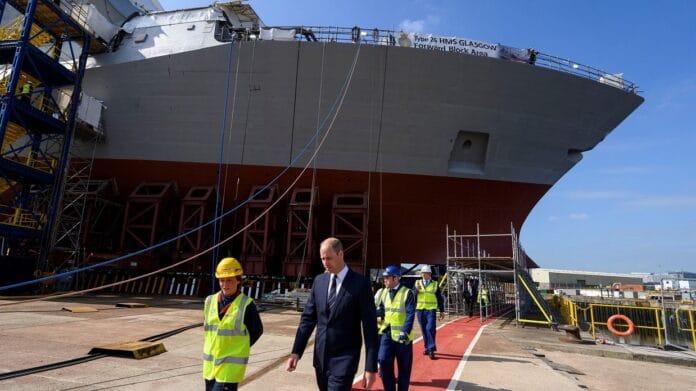In a steel-cut ceremony at BAE Systems’ shipyard in Glasgow, His Royal Highness, Prince William, Duke of Cambridge, set the plasma cutting machine to work on the first plate of steel for the third Type 26 frigate, HMS BELFAST, BAE Systems announced.
Minister of State for Defence Baroness Goldie, together with employees and representatives from the Scottish Government, Royal Navy and the Ministry of Defence, joined the celebrations.
The event marks an important step in the programme to deliver the UK’s latest anti-submarine warfare capability to the Royal Navy, with all three of the first batch of City Class frigates now under construction. The UK-sourced steel plate will form part of a unit which will contain the machinery space for the gearbox and stabilisers of HMS BELFAST.
In recent weeks the first of class, HMS GLASGOW, was rolled out of the build hall into the open for the first time, while progress on HMS CARDIFF continues at pace, with more than 40% of the ship’s units in build at the Company’s Govan shipyard.
Led by electrical apprentice, Cara Shannon, and Type 26 Programme Director, David Shepherd, the Duke of Cambridge enjoyed a tour of HMS GLASGOW during his visit, meeting employees in the ship’s operations room and flight deck.
Minister of State for Defence Baroness Goldie, said: “Today is a significant milestone for the exciting new Type 26 frigate programme and for Defence. We celebrate and receive great support from our UK shipyards. As a Scot, I am very proud of the skills and expertise of our Scottish shipbuilders here on the Clyde.
Rear Admiral Paul Marshall, Director Navy Acquisition, said: “It’s been a privilege to witness this important moment in the life of our third Type 26 frigate and I’m delighted that His Royal Highness The Duke of Cambridge was able to come here today to cut the first steel for the future HMS BELFAST.

“Despite the obstacles of the past year, BAE Systems’ workforce has continued to deliver what will be a world-leading maritime capability that will join an innovative and forward-looking Royal Navy. We are very proud to work closely with industry to realise the immense opportunity that these ships offer to our growing maritime ambition, our international partners and to the whole of the United Kingdom.”
Defence Equipment and Support Director General Ships, Vice Admiral Christopher Gardner, said: “Standing in the shadow of HMS GLASGOW which has been brought together on the hardstanding, with large parts of HMS CARDIFF in construction around us, today’s steel cut for HMS BELFAST is another significant milestone in the delivery of the eight-ship Type 26 class, itself part of the wider Global Combat Ship endeavour that we are part of along with Australia and Canada.
“This is a proud moment for everyone who has worked so hard on this strategic national programme, which sustains thousands of jobs across the United Kingdom and harnesses all of our skills and knowledge to produce the best possible ships for the Royal Navy.”

About Type 26 frigate:
Type 26 is the original variant of BAE Systems’ Global Combat Ship, which Australia and Canada have both selected as the reference design for their anti-submarine frigate programmes, supporting greater operational, training and intelligence ties between the three nations.
The ship will have a displacement of 6,900 tonnes, a length of 149.9 m (492 ft) a beam of 20.8 m (68 ft) and a top speed in excess of 26 knots (48 km/h). The Global Combat Ship will have a core crew of 157 with room for a total of 208. The Global Combat Ship is designed for up to 60 days’ endurance and a range of approximately 7,000 nautical miles (13,000 km).
Located at the stern are facilities allowing for the deployment of rigid-hulled inflatable boats, unmanned surface vehicles or a towed array sonar. A large Integrated Mission Bay and hangar is located amidship, enabling a variety of missions and associated equipment. Aircraft similar in size to the Boeing Chinook can be flown off the large flight deck, and the hangar can accommodate up to two helicopters the size of an AgustaWestland AW159 Wildcat or AgustaWestland Merlin. The hangar also has space to accommodate unmanned aerial vehicles.
Hunter-class frigates will be equipped with 12 cell-VLS containing 48 Sea Ceptor surface-to-air missiles, 24-cell Mark 41 VLS for Tomahawk TLAM/VL-ASROC/LRASM/CAMM/ESSM. The frigates will be equipped with 5-inch 62-calibre Mk 45 Naval Gun, 2×30 mm DS30 Mk2 guns, 2xPhalanx CIWS and several miniguns.
Check out Naval Library App to find out the specifications of the Type 26-class frigates.





